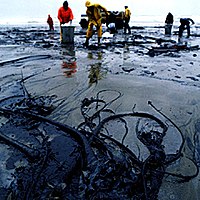
Photo from wikipedia
Oil leaks (or spills) into the aquatic environment are considered a natural disaster and a severe environmental problem for the entire planet. Samples of polyurethane (PU) composites were prepared with… Click to show full abstract
Oil leaks (or spills) into the aquatic environment are considered a natural disaster and a severe environmental problem for the entire planet. Samples of polyurethane (PU) composites were prepared with high specific surface area carbon nanotubes (CNT) to investigate crude oil sorption. Scanning electron microscopy (SEM), Fourier-transform infrared spectroscopy (FT-IR), density measurements, and mechanical compression tests were used to characterize the polyurethane-carbon PU–CNT prepared samples. The spongy composites exhibited good mechanical behavior and a contact angle of up to 119°. The oleophilic character resulted in increased hydrophobicity, a homogeneous oil distribution inside the sponge, and a sorption capacity in a water/oil mixture of 41.82 g/g. Stress-strain curves of the prepared samples showed the good mechanical properties of the sponge, which maintained its stability after more than six sorption desorption cycles. The CNT–PU composites may prove very effective in solving oil pollution problems.
Journal Title: Materials
Year Published: 2022
Link to full text (if available)
Share on Social Media: Sign Up to like & get
recommendations!